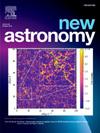用XMM-Newton研究ngc1453中超亮x射线源的性质
IF 2.1
4区 物理与天体物理
Q2 ASTRONOMY & ASTROPHYSICS
引用次数: 0
摘要
本文基于两个xmm -牛顿观测数据,对大质量椭圆星系NGC 1453的非核x射线点源进行了多历元、详细的光谱和时间分析。在Obs ID为0901620101的观测中,鉴定出净计数≥100的7个来源的PN数据,并考虑其相应的MOS数据进行分析。在Obs ID为0673770601的观测中,只发现了3个PN源和2个MOS-1和MOS-2源。利用吸收幂律模型和吸收盘黑体模型两种经验模型同时拟合了所有源的光谱。根据估算出的X-1、X-2、X-3、X-4、X-6和X-7 6个源在误差范围内被归类为hlx,其x射线光度为LX>;1041ergs−1,而X-5为ELX,其x射线光度为LX>;1040ergs−1。值得注意的是,对于源X-1,盘状黑体分量是两次观测的主要特征。在2012年的观测(Obs ID 0673770601)中,源显示出一个柔软、凉爽的吸积盘,内盘温度为kTin ~ 0.27 keV。到2022年(Obs ID 0901620101), X-1呈现出更加柔软的超软光谱,其特征是内盘温度显著降低,为kTin ~ 0.17 keV,光子指数Γ>;5. 这一跨越十年的转变表明了源头的进一步软化。在本研究中,由于数据可用性有限,不能严格约束亮度-温度(L-T)关系。然而,为了估计质量,我们假设L ~ T4关系成立。观测到的源(X-1)的进一步软化,伴随着后期观测中亮度的轻微增加,表明软成分的盘内温度与光度之间存在潜在的负相关关系,这与超级爱丁顿吸积系统中预期的由辐射驱动的强外流风导致的束状盘发射特征相一致。X-4和X-7的光谱相对较软,kTin ~ 0.5 ~ 0.7 keV, Γ>;2. 源X-2、X-5和X-6表现出硬光谱状态(Γ ~ 1.5-1.8),而源X-2在两次观测中都被检测到,没有任何显著的光谱变化。对于源X-3,在后来的观测中观察到光谱略有硬化。源的硬谱态可能是由最内层的逆复化或吸积流引起的。使用卡方概率恒常性检验的时间分析显示,在99%的置信水平下,除了观测到的源X-1在1 ks时间间隔内(Obs ID 0901620101),所有源在千秒时间间隔内没有可变性。以X-1为例,在10ks时间尺度上,本征红噪声压倒泊松噪声,表明吸积盘中可能存在潜在的光束效应或不稳定性。此外,通过使用lcstat工具在0.1 ks、0.5 ks和1 ks的不同时间箱中计算RMS分数变异性(Fvar)来量化变异性。此外,它们的功率密度谱中没有脉动,这表明这些超亮x射线源(ULXs)——HLXs和ELX不太可能是由脉动中子星提供能量的。本文章由计算机程序翻译,如有差异,请以英文原文为准。
Studying the nature of Ultraluminous X-ray sources in NGC 1453 with XMM-Newton
This paper presents a multi epoch, detailed spectral and temporal analysis of the non-nuclear X-ray point sources of the massive elliptical galaxy NGC 1453, based on two XMM-Newton observational data. In the observation with Obs ID 0901620101, seven sources having net counts 100 were identified for PN data, which along with their corresponding MOS data were considered for the analysis. For the observation with Obs ID 0673770601, only three sources were found for PN and two sources for MOS-1 and MOS-2. The spectra of all the sources were simultaneously fitted using two empirical models: an absorbed power-law model and an absorbed disk blackbody model. Based on the estimated bolometric luminosities of the sources, six sources - X-1, X-2, X-3, X-4, X-6 and X-7 are categorized as HLXs with X-ray luminosity, while one source, X-5, as an ELX with , within the error limit. Notably, for source X-1, the disk blackbody component is the dominant feature in both the observations. In the 2012 observation (Obs ID 0673770601), the source exhibits a soft, cool accretion disk with an inner disk temperature of 0.27 keV. By 2022 (Obs ID 0901620101), X-1 presents an even softer, supersoft spectrum, characterized by a significantly lower inner disk temperature of 0.17 keV and photon index 5. This shift over the span of a decade indicates a further softening of the source. In the present study, due to limited data availability, the Luminosity-Temperature (L-T) relation could not be strictly constrained. However, for the purpose of mass estimation, we have assumed that the L relation holds. The observed further softening of the source (X-1), accompanied by a slight increase in luminosity in the later observation, suggests a potential inverse correlation between the inner disk temperature of the soft component and luminosity, which is consistent with the characteristics of beamed disk emission resulting from radiatively driven, strong outflowing winds, as expected in super-Eddington accretion system. The spectra of sources X-4 and X-7 were found to be relatively soft, with 0.5–0.7 keV and 2. Sources X-2, X-5, and X-6 exhibit a hard spectral state ( 1.5–1.8), while the source, X-2 was detected in both observations without any significant spectral variations. For the source, X-3, a slight hardening of the spectrum was observed in the later observation. The hard spectral states of the sources may arise from the inverse Comptonization or accretion flow in the innermost region. Temporal analysis using the Chi-square probability of constancy test reveals no variability for all sources at kilosecond time binnings, at a 99% confidence level, except for source X-1 at 1 ks time binning for the observation (Obs ID 0901620101). In the case of X-1, intrinsic red noise dominates over Poisson noise at 10 ks time scale, indicating the possibility of potential beaming effects or instabilities within the accretion disk. Further, the variability was quantified by calculating the RMS fractional variability () using the lcstat tool, at different time bins of 0.1 ks, 0.5 ks, and 1 ks. Moreover, the absence of pulsations in their power density spectra suggests that these Ultra-Luminous X-ray Sources (ULXs)- the HLXs and ELX are unlikely to be powered by pulsating neutron stars.
求助全文
通过发布文献求助,成功后即可免费获取论文全文。
去求助
来源期刊

New Astronomy
地学天文-天文与天体物理
CiteScore
4.00
自引率
10.00%
发文量
109
审稿时长
13.6 weeks
期刊介绍:
New Astronomy publishes articles in all fields of astronomy and astrophysics, with a particular focus on computational astronomy: mathematical and astronomy techniques and methodology, simulations, modelling and numerical results and computational techniques in instrumentation.
New Astronomy includes full length research articles and review articles. The journal covers solar, stellar, galactic and extragalactic astronomy and astrophysics. It reports on original research in all wavelength bands, ranging from radio to gamma-ray.
 求助内容:
求助内容: 应助结果提醒方式:
应助结果提醒方式:


